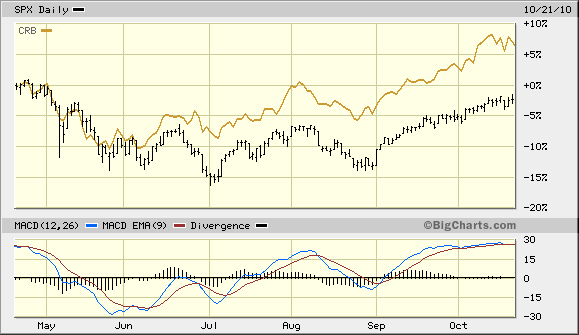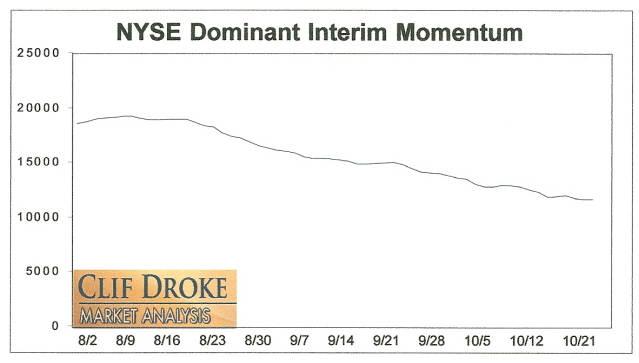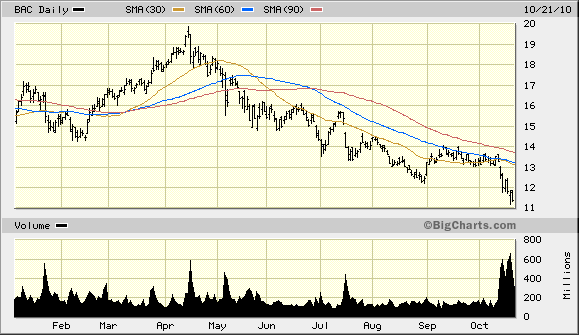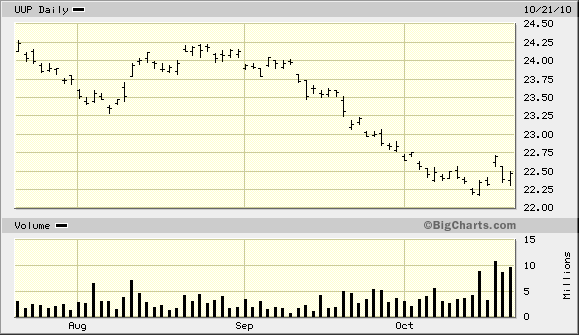The chart featured below shows the CRB commodity price index compared to the S&P 500. Commodity prices, as you can see, have rallied vigorously in the last several weeks and have received the benefit of speculation over quantitative easing, in which the Fed buys up big chunks of government debt. The consensus view is that quantitative easing would most likely put more pressure on the dollar and create another incentive for investors to turn to commodities as a safe haven for a weak dollar.

Writing in the latest issue of Barron's in response to quantitative easing, Anna Raff writes, "The problem is that if the Fed really does crank up the printing presses, it will be a sign that the economy is in worse shape than many had thought. . .In other words, the recent runup may well be unsustainable."
Another example of the guessing game being played by the pundits can be seen in the latest commentary by Newsweek columnist Robert Samuelson. He writes, "Banks have excess reserves of roughly $1 trillion. But if all the cheap money eventually spurred much higher economic growth, many of these reserves would turn into loans and raise the specter of higher inflation – 'too much money chasing too few goods.'" He goes on to quote economist Allan Meltzer of Carnegie Mellon University, who said: "Sooner or later, we'll have a big inflation but not right away because there's no demand right now."
This seems to be the conclusion of many analysts, who view with skepticism the rally since early September. The guessing game of trying to figure out what the market's next move will be is even more prevalent than questioning the sustainability of the current rally. The problem with trying to use reason or logic to justify the market's response (or anticipated response) to monetary policy is that you can never rely on the market to be totally logical for very long. The rules of the game have changed in just the last few years and the days of "buy and hold" are over. To win on today's Wall Street you must be prepared to adapt quickly to the seemingly illogical movements of the stock market. This is where technical trading gives us a distinct edge over investors who insist on trying to outthink the market (which is never a good idea).
Dennis Slothower, writing in a recent issue of "Stealth Stocks," commented, "The Fed should not be driving up commodities now and threatening to spend another trillion. . ..They are trying to suck as many players into the markets as possible so the primary dealers have someone to feed on." The consensus view agrees with Mr. Slothower that the Fed's second quantitative easing program (QE2) will further fuel the rally in commodity prices and create a situation not unlike the one preceding the 2008 financial crisis. But it wouldn't be wise to make any longer-term bets on this view since in today's upside-down financial marketplace logic doesn't dictate market moves. Hedge funds largely determine the short-term moves and there often doesn't seem to be any logic behind these, either. The trick is to use the technical indicators to "shadow" the funds and follow their footsteps until the momentum reverses.
The past several weeks have unquestionably been tricky and few analysts predicted the September rally in advance. It seemed to come out of nowhere even as all signs pointed to a re-test of the early July lows. Yet the market always seems to have a built-in monkey wrench ready to be thrown into the machinery at a moment's notice. So far nothing has been able to trip up this rally but the proverbial monkey wrench is easily identifiable: it's the dominant interim momentum indicator, which is based on a rate of change in the NYSE new highs-new lows. This particular indicator has been stubbornly in decline since April and has kept us (rightly or wrongly) from becoming overly bullish on this market. We've ventured a few trades and have some profitable long positions in our trading portfolio but we've kept our long positions to a minimum until this important indicator reverses its downward trend. My expectation has been that the dominant interim momentum indicator would reverse soon after the bottoming of the 4-year cycle. The 4-year cycle has since bottomed. And while the NYSE hi-lo differential has shown substantial improvement since then, the dominant interim momentum indicator hasn't yet reversed its decline.

The fact that this particular indicator is in a downtrend creates a potential problem for the stock market. The other components of the stock market's internal momentum are mostly in uptrends, which is what has help to keep the market's uptrend intact. It appears, though, that the negative internal current created by the intermediate-term indicator is being most strongly felt in the bank stocks, with one high profile stock in particular, Bank of America, bearing the brunt of the selling pressure. For this reason it would be wise to embrace a conservative stance toward the market, maintaining only a small number of trades and using conservative stops in case the broad market sharply reverses in the near term. Only when the interim momentum indicator shows decided improvement will the air be cleared enough to embrace an uninhibited bullish bias.

After a magnificent run which saw the SPDR Gold ETF (GLD), our proxy for the gold price, rally from 117 to 135 over a 10-week period, the GLD finally broke its immediate-term uptrend earlier this week. It's highly unusual to see the ETF rally more than six consecutive weeks without violating the 15-day moving average but this rally was a testimony to the relentless weakness in the U.S. dollar index as much as the strong demand for gold. The break of the immediate uptrend in the GLD was accompanied by a push above the main downtrend line in the dollar ETF (UUP). While this doesn't formally break the interim downtrend in the dollar, it does send a "heads up" signal for the near term and suggests a relief rally could be imminent for the dollar.

The corresponding correction in the gold price is actually much to be desired as it will take much of the excess heat out of the market. The gold market never actually became "irrationally exuberant" during the past two month's rally but it was becoming notably more frothy. A rash of mainstream news articles extolling the virtues of the yellow metal were making their appearance and in the process were enough to make a contrarian investor nervous. The gold price pullback will accordingly do much to remove the shine from the market – a desirable development from a contrarian standpoint.
Moving Averages
With the return of volatility anticipated in 2010, it will be important to have a technically sound trading discipline. Classical trend line methods can be useful but they aren't particularly suited for a fast-moving, dynamic market environment. This is especially true where turning points occur rapidly in a market that is subject to cyclical crosscurrents as 2010 is likely to be. That's where moving averages come in handy.
With a good moving average system a trader can be reasonably assured of catching most of the important moves in an actively traded stock or ETF while eliminating many of the whipsaws that attend trading choppy markets. In the book "Stock Trading with Moving Averages" we discuss some market-tested methods that have proven successful across most major stock sectors and industry groups, and is especially geared toward the gold and silver mining stocks and ETFs. Here's what one reader had to say about the book: "...you were the one who supercharged my charting with your moving average book 'Stock Trading with Moving Averages' and your constant analysis of the double and triple moving average series."
Moving averages offer another advantage over trend lines in that they can be tailored to closely fit the dominant short-term and interim market cycles. They're also more compatible with a trading range-type market. . .if you use the right moving average system. These and other strategies and tactics are discussed in "Stock Trading with Moving Averages." Order your copy today and receive as an added bonus my two latest Special Reports on moving average trading and how to use stock market cycles for optimal timing. Click here for more info:
http://www.clifdroke.com/books/book14.mgi
Clif Droke is the editor of the three times weekly Momentum Strategies Report newsletter, published since 1997, which covers U.S. equity markets and various stock sectors, natural resources, money supply and bank credit trends, the dollar and the U.S. economy. The forecasts are made using a unique proprietary blend of analytical methods involving cycles, internal momentum and moving average systems, as well as investor sentiment. He is also the author of numerous books, including most recently "The Stock Market Cycles." For more information visit www.clifdroke.com


















































